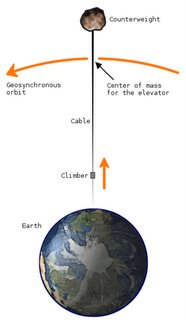 I used to think talk about elevators to space was just science fiction, but it looks like there are some people out there trying to make this an actual reality. Here’s a quote explaining more about it from Business 2.0 (courtesy of Gizmodo):
I used to think talk about elevators to space was just science fiction, but it looks like there are some people out there trying to make this an actual reality. Here’s a quote explaining more about it from Business 2.0 (courtesy of Gizmodo): Earth is constantly spinning. So if you attach a counterweight to it with a cable, and put it far enough away—62,000 miles—the cable will be held taut by the force of the planet’s rotation, just as if you spun around while holding a ball on a string. And if you’ve got a taut cable, you’ve got the makings of an elevator.
As strange as that sounds—push the “Up” button, climb in, and soar off into weightless bliss—don’t be surprised if it happens. The space elevator is where the PC was in the 1960s: The theory is solid, the materials exist, and people in garages are starting to tinker with the next step. Two Seattle startups are competing to build the elevator. Both believe they can do it within 15 years at a cost of $10 billion. NASA and China’s space agency are eager to
help make it happen.And no wonder: A working elevator would reduce the cost of launching anything into space by roughly 98 percent.
If anyone succeeds in making this a reality, it would completely change the dynamics and cost-structures of all industries connected with space – satellites, space travel, etc. Who knows what new innovations might emerge from this?
Here’s a website explaining more about how this might work. Also, Instapundit’s Glenn Reynolds has several articles on this here, here and here.
Anyone up for a 62,000 mile elevator ride?
1 comment:
If anyone succeeds in making this a reality, it would completely change the dynamics and cost-structures of all industries connected with space – satellites, space travel, etc. Who knows what new innovations might emerge from this?
We prefer to say 'when' but then we're biased.
You're right - we can't know what will come of all this. But it is certain that when you lower the transaction cost of getting from here to there wealth is generated on both ends of the node, and cost savings ripple outward in strange and hard to predict ways.
When I get really introspective I remember that a few years after Watt perfected the steam engine all the graphs for the British economy kinked upward like a rocket and kept going. Same thing here, or so we hope.
Brian Dunbar
Liftport
Post a Comment